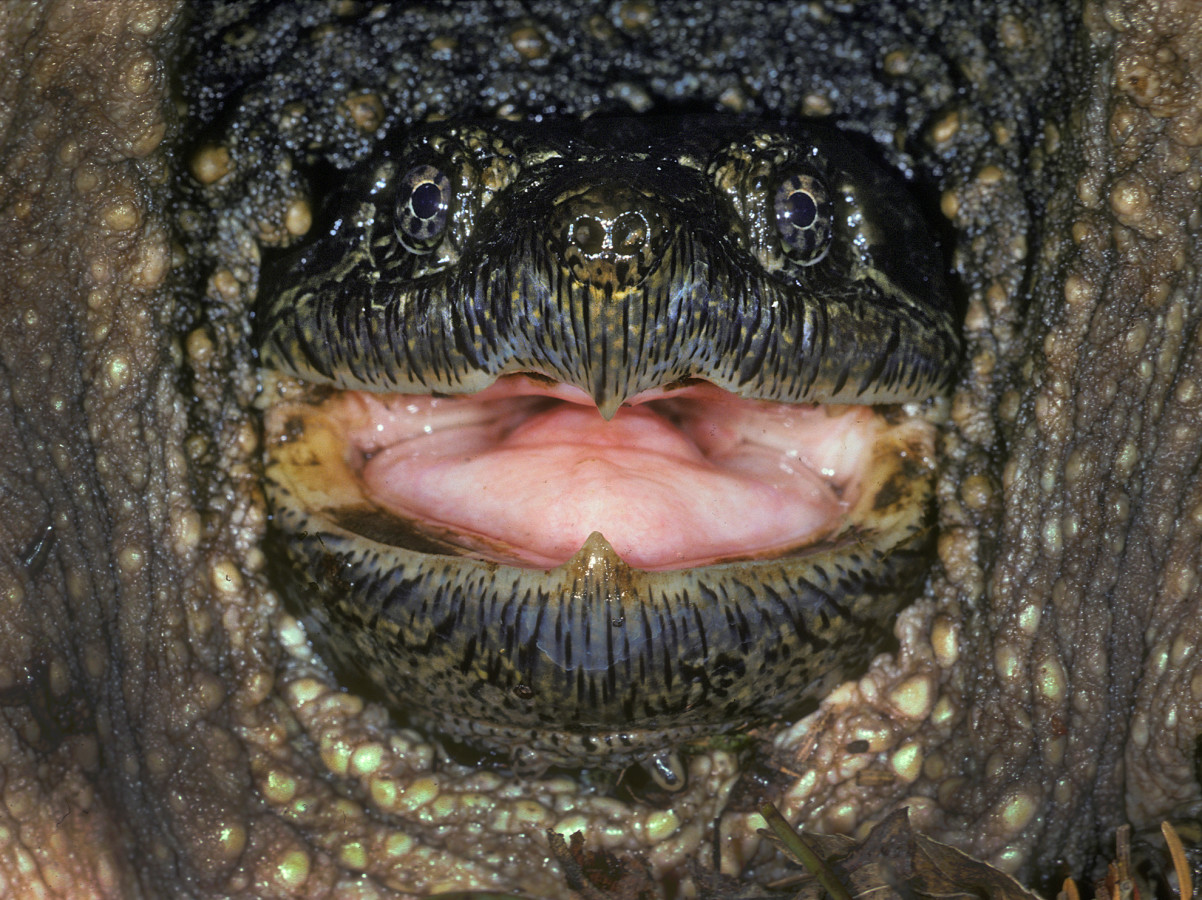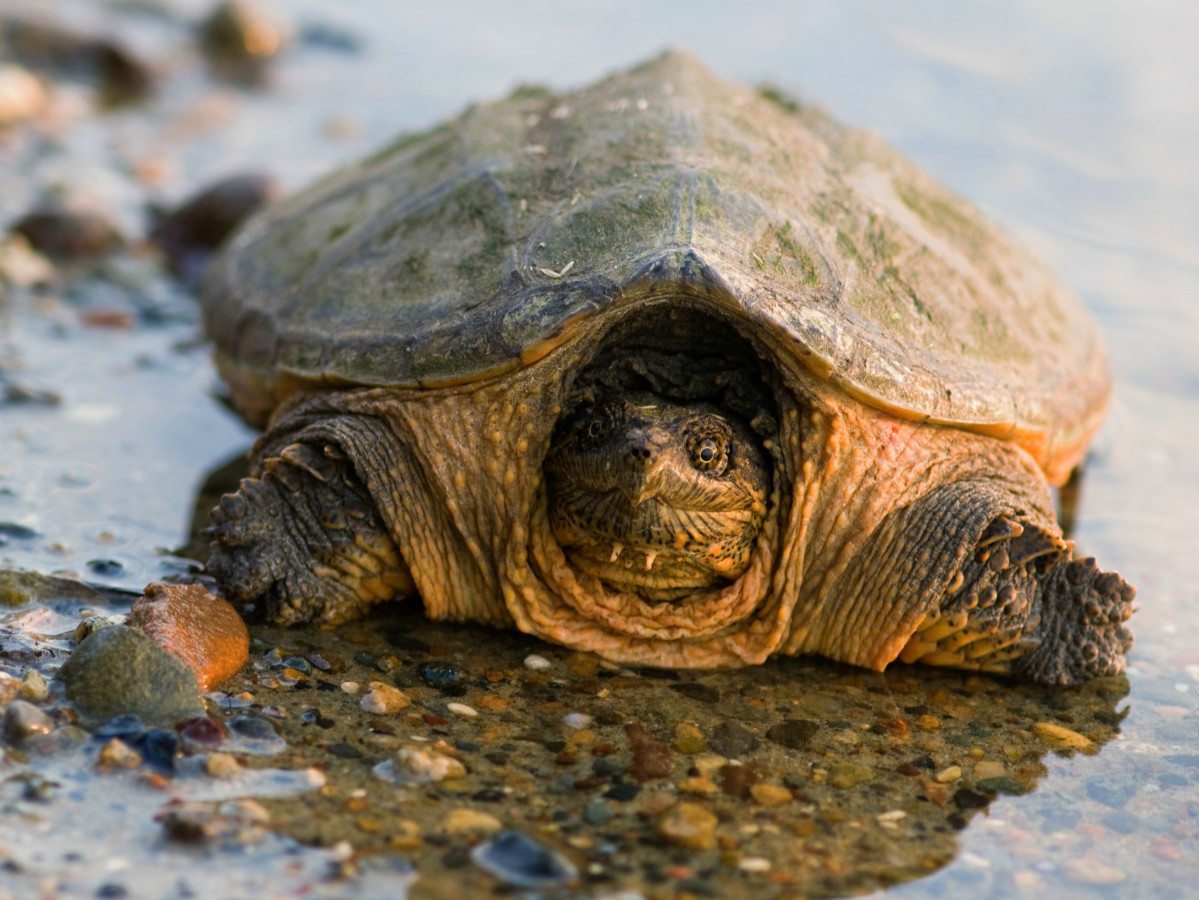With its long, spiny tail, muscular legs, long claws, and low, flattened carapace, the common snapping turtle (Chelydra serpentina) looks ponderous and primitive, rather like an iguana trying to hide beneath a snow saucer.
Although not nearly as daunting as its much larger southern cousin, the alligator snapping turtle, it’s no slouch, either: it can reach 35-45 pounds, with a shell over a foot long; exceptional individuals may grow even larger.
The snapping turtle appears prehistoric because it is. The genus Chelyridae evolved in North America 90 million years ago, and modern specimens look very little different from their ancestors. While giant marine reptiles swam in the shallow sea that covered much of North America and the Tyrannosaurus Rex and Triceratops squared off on land, chelydrids hunkered down in the mud. They survived the meteor impact 65 million years ago that killed the dinosaurs and have weathered countless natural and man-made disasters. These tough reptiles can eat almost anything and live almost anywhere, including polluted bodies of water with low oxygen levels, and even sewer systems. Although they are the official state reptile of New York, they are found everywhere from southern Canada to the Gulf of Mexico, from the east coast to the Rockies.
The snapper’s scientific name means “snake-like turtle,” a reference to its very long, agile neck, which it can whip out with unnerving speed to grab prey items or warn off would-be predators. Apart from its rather unpredictable business end, however, the animal is very sedentary. It prefers to spend its days hidden by mud and algae at the bottom of shallow, still or slow-moving, bodies of water. Every now and then, it will lift its long neck to the surface to take a sip of air. When it needs to get around, it usually walks or bounces along the bottom rather than swimming. The majority of its diet is made up of plants and slow-moving fish, but it will also eat carrion, invertebrates, amphibians, and anything else that happens to float by. Its reputation for taking game fish or waterfowl is undeserved, however; although it will snatch a duckling if it gets the chance, in general, it is simply too slow to catch healthy, fast-moving animals.
In the water, the snapping turtle is surprisingly unsnappish and will flee rather than retaliate, even when stepped on. However, it is usually cantankerous on land, perhaps because it feels vulnerable: unlike many other turtles, it cannot pull its head and legs into its shell. Snappers are most likely to be ashore in the summer; between late May and early July, the females search for nest sites, and animals of both sexes sometimes bask on sun-warmed asphalt. The jury is out as to whether a snapping turtle can actually snap off a finger, but it can undoubtedly do a lot of damage with its sharp beak. If you find one on land, it is wisest to leave it alone. If you must pick it up, hold its back end firmly, keeping your hands as far away from the head as possible; never pick one up by its tail.
Snappers live a very long time, mature very late, and lay a relatively small number of eggs per year. This strategy helps the species survive an unpredictable environment in which harsh weather and heavy predation kill almost all turtles before they reach breeding age. Unfortunately, it also means that populations can be devastated by the loss of adult animals. Many turtles, especially females looking for nest sites, are struck and killed by cars. In addition, the demand for turtle meat has increased in recent years and in some areas of the country – though not yet in the Finger Lakes – populations of snapping turtles have dropped precipitously; once again, gravid females are the most vulnerable because they are the most mobile. The turtles have the last laugh, however: since they are at the top of the food chain and live a long time in nutrient-rich waters, their flesh is often heavily contaminated with toxins.
The populations of many other native turtles are in steep decline, but snappers generally seem to be holding their own. If the past is any guide, they’ll probably still be here long after we’re gone.



